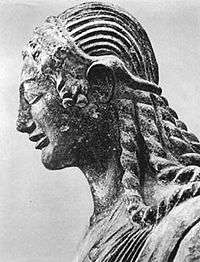Fescennia
Fescennia or Fescennium was an ancient city of Etruscan/Faliscan origin, which is probably to be placed immediately to the north of the modern Corchiano, 6 miles (9.7 km) north west of Civita Castellana, in central Italy.[1] The Via Amerina traverses it. At the Riserva S. Silvestro, walls exist. At Corchiano itself, however, similar walls may be traced, and the site is a strong and characteristic triangle between two deep ravines, with the third (west) side cut off by a ditch. Here, too, remains of two bridges may be seen, and several rich tombs have been excavated.[2][3][4]
The term Fescennine Verses refers to a certain kind of drinking song popular at festivals in ancient Rome and elsewhere. According to Festus, these songs were introduced from Fescennia, but others have thought that there is no reason to assume that any particular town was specially devoted to the use of such songs.[5]
Notes
- ↑ Harris, W., DARMC, R. Talbert, S. Gillies, T. Elliott, J. Becker. "Places: 413133 (Fescennium)". Pleiades. Retrieved November 8, 2014.
- ↑ Chisholm 1911, p. 292.
- ↑ Sir William Smith (1872). A Dictionary of Greek and Roman Geography. J. Murray. pp. 897–.
- ↑ George Dennis (1848). The Cities and Cemeteries of Etruria. John Murray. pp. 151–.
- ↑ Chisholm 1911b, p. 292.
References
-
 Chisholm, Hugh, ed. (1911b). "Fescennine Verses". Encyclopædia Britannica. 10 (11th ed.). Cambridge University Press.
Chisholm, Hugh, ed. (1911b). "Fescennine Verses". Encyclopædia Britannica. 10 (11th ed.). Cambridge University Press.
Attribution
-
 This article incorporates text from a publication now in the public domain: Chisholm, Hugh, ed. (1911). "Fescennia". Encyclopædia Britannica. 10 (11th ed.). Cambridge University Press. This work in turn cites:
This article incorporates text from a publication now in the public domain: Chisholm, Hugh, ed. (1911). "Fescennia". Encyclopædia Britannica. 10 (11th ed.). Cambridge University Press. This work in turn cites:
- A. Buglione, “Conte di Monale,” in Römische Mitteilungen (1887), p. 21 seq.
